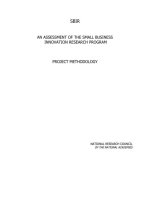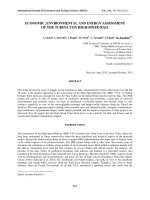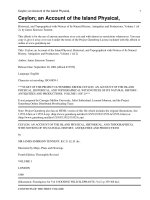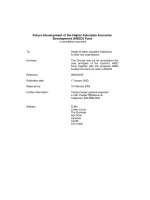Assessment of the Budget 2010 Economic and Fiscal Outlook pot
Bạn đang xem bản rút gọn của tài liệu. Xem và tải ngay bản đầy đủ của tài liệu tại đây (570.85 KB, 14 trang )
Assessment of the Budget 2010 Economic and Fiscal Outlook
Ottawa, Canada
March 11, 2010
www.parl.gc.ca/pbo-dpb
Assessment of the Budget 2010 Economic and Fiscal Outlook
i
Prepared by:
Russell Barnett, Jeff Danforth, Chris Matier and Brad Recker
__________________________________________________________________________________________
The authors thank Mostafa Askari and Kevin Page for helpful comments. Any errors or omissions are
the responsibility of the authors.
The Parliament of Canada Act mandates the Parliamentary Budget Officer
(PBO) to provide independent analysis to the Senate and House of
Commons on the state of the nation’s finances, government estimates and
trends in the national economy. The following note provides an
assessment of the economic and fiscal outlook presented in Budget 2010.
Assessment of the Budget 2010 Economic and Fiscal Outlook
ii
Key Points
This note assesses the economic and fiscal outlook presented in Budget 2010. PBO’s assessment
of the Budget 2010 outlook is, however, limited by the lack of detailed information and data
pertaining to the Government’s assumptions that underlie the translation of the private sector
economic forecast into the fiscal forecast presented in Budget 2010. To assess the fiscal
projections in Budget 2010, PBO has prepared a fiscal outlook based on the same private sector
economic forecast used by the Department of Finance Canada to prepare the Budget 2010 fiscal
projections. As a result, the source of difference between PBO’s fiscal projections and those in
Budget 2010 is limited to the assumptions used to translate the economic forecast into fiscal
projections.
PBO believes that the private sector economic outlook, on which Budget 2010 fiscal projections
are based, provides a reasonable basis for fiscal planning. That said, PBO disagrees with the
overall characterization of the Canadian economic situation and outlook in Budget 2010.
Based on IMF estimates and projections, the severity of the recession in Canada is in
line with the experience of other G7 countries.
PBO believes that the dispersion of private sector forecasts likely underestimates the
actual magnitude of uncertainty surrounding the economic outlook.
PBO believes that the risks to the private sector economic outlook for nominal GDP are
roughly balanced but would not characterize this outlook as a ‘prudent’ basis for fiscal
planning.
Based on the private sector economic forecast presented in Budget 2010, the Government’s
estimates of savings and policy measures, as well as the Government’s forecast of underlying
direct program spending, PBO projects budgetary deficits that are, on average, in line with the
Budget 2010 forecast from 2009-10 to 2012-13. However, over the medium term, PBO projects
budgetary deficits that are somewhat larger. For 2013-14 and 2014-15, PBO projects deficits of
$16.3 billion and $12.3 billion (0.9 and 0.6 per cent of GDP) respectively compared to budgetary
deficits of $8.5 billion and $1.8 billion (0.5 and 0.1 per cent of GDP) respectively in Budget 2010.
2009-10 2010-11 2011-12 2012-13 2013-14 2014-15
Budgetary balance:
($ billions)
PBO -53.0 -46.9 -27.0 -20.6 -16.3 -12.3
Budget 2010 -53.8 -49.2 -27.6 -17.5 -8.5 -1.8
difference 0.8 2.3 0.6 -3.1 -7.8 -10.5
Despite announced savings measures of $17.6 billion in Budget 2010, PBO estimates that the
structural deficit will decline only gradually to $13.7 billion in 2014-15. Relative to the size of the
economy, these structural deficits are significantly smaller than the structural deficits observed in
Assessment of the Budget 2010 Economic and Fiscal Outlook
iii
the 1980s and early 1990s. PBO’s estimate of the structural deficit does not mean that the
Government’s budget will not return to balance. Rather it suggests that achieving budgetary
balance would require: the economy operating significantly above its potential; actions to
increase revenues or reduce spending relative to their projected paths; or, some combination
thereof.
2009-10 2010-11 2011-12 2012-13 2013-14 2014-15
($ billions)
Structural balance -15.6 -16.6 -13.8 -13.2 -13.7 -13.7
Based on the private sector economic forecast presented in Budget 2010, PBO and the
Government project the federal debt-to-GDP ratio to decline gradually over the medium term to
32.8 and 31.9 per cent respectively, in 2014-15. This level is relatively low on a historical basis
and likely significantly lower than other central governments when put on a comparable basis.
However, despite the savings measures announced in Budget 2010, and based on the
assumptions and projections presented in PBO’s recent Fiscal Sustainability Report, the
Government’s fiscal structure remains unsustainable over the long term.
Assessment of the Budget 2010 Economic and Fiscal Outlook
1
1. Objective
The purpose of this note is to assess the economic
and fiscal outlook presented in Budget 2010. To
this end, PBO has prepared a fiscal outlook based
on the same private sector economic forecast used
by the Department of Finance Canada for Budget
2010. PBO’s intention is to limit the source of the
differences between the two outlooks to the
assumptions used to translate the economic
forecast into fiscal projections. However, PBO’s
assessment of the Budget 2010 economic and fiscal
outlook is limited by the lack of detailed
information and data pertaining to the
Government’s assumptions that underlie the
translation of the private sector economic forecast
into the fiscal forecast presented in Budget 2010.
2. Economic and Fiscal Forecasting
The fiscal projections presented in Budget 2010, as
well as those produced by PBO for this note, are
based on the results of the Department of Finance
Canada’s survey of economic forecasts produced
by private sector organizations. The survey is used
to provide average forecasts for key
macroeconomic indicators that are required for
producing fiscal projections. The Department of
Finance Canada then translates the average of
private sector forecasts of these macroeconomic
indicators into a fiscal forecast, based on its own
assumptions, which are not disclosed. For
example, producing fiscal projections requires
assumptions about the composition of nominal
GDP. As highlighted in PBO (2009a), these
assumptions play an important role in fiscal
projections because different components of GDP
are taxed at different rates. Annex A provides
PBO’s assumptions regarding the income
composition of GDP.
1
1
In 2008 and 2009, PBO requested from the Department of Finance
Canada the income and expenditure assumptions underlying nominal
GDP (as well as the data to calculate effective tax rates) that were
used to develop their status quo fiscal projections. This information
was deemed a Cabinet confidence by the Privy Council Office and
therefore was not provided.
The practice of using private sector economic
forecasts in the preparation of fiscal projections
has been adopted by successive governments and
has been strongly supported by the International
Monetary Fund (IMF). That said, although the use
of private sector forecasts enhances the
independence and, therefore, the credibility of the
Government’s fiscal projections, the Government’s
established practice of not providing the
assumptions used by the Department of Finance
Canada to translate the private sector economic
forecast of these indicators into fiscal projections,
as well as details regarding planned and approved
program spending by departments, impedes a
complete assessment of the reasonableness of the
Government’s fiscal projections.
This lack of transparency was highlighted in the
2005 Review of Canadian Fiscal Forecasting and
IMF staff have also noted that the Government
“could enhance the understanding of budgetary
forecasts by providing more information on the
assumptions and methods underlying the
translation of the macroeconomic outlook into
fiscal projections.”
2
A complete assessment of the
fiscal outlook presented in Budget 2010 requires
this additional information.
3. Economic Outlook
PBO believes that the economic outlook, on which
Budget 2010 fiscal projections are based, provides
a reasonable basis for fiscal planning. That said,
PBO disagrees with the overall characterization of
the Canadian economic situation and outlook in
Budget 2010.
Budget 2010 asserts that Canada has been able to
weather the global economic recession “better
than all other major industrialized countries” (p.
24), presenting comparisons of the contractions in
GDP across G7 countries. However, because each
country has different trends in labour supply and
productivity growth, an appropriate comparison
must examine how each economy has performed
relative to its trend/potential GDP. Such
2
See O’Neill (2005) and Mühleisen et al. (2005).
Assessment of the Budget 2010 Economic and Fiscal Outlook
2
comparisons can be made using IMF estimates and
projections of each country’s GDP relative to its
potential GDP, which is referred to as the output
gap (Table 3-1).
Table 3-1
G7 Output Gap Comparison
(Per cent of potential GDP)
2007 2008 2009 2010 2011 2012 2013 2014
Canada 1.2 -0.5 -4.6 -4.1 -2.2 -0.8 -0.2 0.0
France 1.0 0.0 -3.2 -3.2 -2.4 -1.6 -0.7 0.3
Germany 0.9 1.0 -3.6 -3.3 -2.4 -1.5 -0.6 0.0
Italy 1.6 -0.1 -3.4 -3.5 -3.1 -2.2 -1.2 0.0
Japan 0.2 -1.7 -7.0 -5.5 -3.6 -2.1 -1.0 -0.4
United Kingdom 0.4 -0.1 -4.9 -4.7 -3.5 -2.2 -1.0 0.0
United States 0.7 -0.8 -4.5 -3.9 -2.2 -0.9 -0.1 0.0
Source: International Monetary Fund.
Note: The output gap estimate for Canada is the IMF’s estimate.
Despite the fact that the global recession
originated outside of Canada, the IMF estimates
that the severity of the recession in Canada is in
line with the experience of other G7 countries.
IMF estimates also show that the Canadian
economy will incur a cumulative 12.3 per cent loss
in GDP relative to its potential over 2009 to 2014,
which would place Canada fourth relative to its G7
counterparts (Figure 3-1).
Figure 3-1
Cumulative GDP Loss Relative to Potential GDP
(Per cent)
-10.8
-11.5
-12.3
-12.3
-13.5
-16.4
-21.2
-25
-20
-15
-10
-5
0
-25
-20
-15
-10
-5
0
France
Germany
United
States
Canada
Italy
United
Kingdom
Japan
Source: International Monetary Fund.
PBO believes the measure and characterization of
uncertainty in Budget 2010 to be inappropriate.
Budget 2010 states that “the uncertainty
surrounding the medium-term outlook has
diminished significantly since the September
Update” (p. 34) and illustrates this by showing the
difference between the high and low levels of the
nominal GDP forecasts in 2013. PBO finds this
conclusion inappropriate since no additional
analysis has been provided to show that the
dispersion of private sector forecasts is a
reasonable and statistically significant measure of
forecast uncertainty. In fact, research examining
the dispersion of private sector forecasts as a
measure of uncertainty for Canada and other
countries is not conclusive. As a result, more
thorough analysis is required to draw the
conclusion that there has indeed been a reduction
in forecast uncertainty.
PBO also believes that the dispersion of private
sector forecasts likely underestimates the actual
magnitude of uncertainty surrounding the
economic outlook. For example, work done at the
Department of Finance Canada estimates that the
90 per cent confidence interval for the level of
nominal GDP in the fourth year of the forecast
horizon to be approximately plus or minus seven
per cent of nominal GDP.
3
This confidence interval
is significantly larger than the dispersion of private
sector forecasts presented in either the September
2009 Update of Economic and Fiscal Projections or
Budget 2010.
Budget 2010 notes the stronger-than-expected
nominal GDP growth in the fourth quarter of 2009
and the apparent inclusion of medium-term
downside risks to the outlook. However, PBO
continues to view the risks to the private sector
outlook for nominal GDP – the broadest measure
of the Government’s tax base – as roughly
balanced, with the downside risks to real GDP
growth offset by upside risks to GDP inflation (see
PBO (2009b)).
4
The fiscal implications of these
3
For more details see Robbins, Torgunrud and Matier (2007).
4
On the downside, the main risk is that real GDP growth could be
lower, reflecting a weaker-than-anticipated global economic recovery,
Assessment of the Budget 2010 Economic and Fiscal Outlook
3
risks, however, are not symmetric and therefore
not offsetting. That is, lower real GDP growth
could be offset by higher GDP inflation leaving
nominal GDP growth unchanged; however, the
Government’s budgetary balance would be
(negatively) impacted since shocks to real GDP
growth typically have a larger fiscal impact than
shocks to GDP inflation (e.g., see pp. 188-191 in
Budget 2010).
Further, in the recent past, prudence had been
explicitly included in the forecast by incorporating
a downward adjustment to nominal GDP, as was
done in Budget 2009, or through the inclusion of
an explicit contingency reserve and economic
prudence as had been the case in past budgets. No
such explicit adjustments have been made to the
economic or fiscal projection.
As a result, PBO would not characterize the private
sector economic outlook as a ‘prudent’ basis for
fiscal planning.
4. Fiscal Outlook
Based on the private sector economic forecasts
presented in Budget 2010, the Government’s
estimates of savings and policy measures, as well
as the Government’s forecast of underlying direct
program spending (DPS), PBO projects budgetary
deficits that are on average in line with the Budget
2010 forecast from 2009-10 to 2012-13 (Table 4-1).
However, over the medium term, PBO projects
budgetary deficits that are somewhat larger. For
2013-14 and 2014-15, PBO projects budgetary
deficits of $16.3 billion and $12.3 billion (0.9 and
0.6 per cent of GDP) respectively compared to
budgetary deficits of $8.5 billion and $1.8 billion
(0.5 and 0.1 per cent of GDP) respectively in
Budget 2010. Further, while PBO views the risks to
the private sector outlook for nominal GDP in
Budget 2010 to be roughly balanced, PBO believes
particularly given the synchronized and financial nature of the
downturn. On the upside, the outlook for GDP inflation could exceed
private sector forecasts in Budget 2010, reflecting uncertainties in
mapping expected commodity price and terms of trade movements
into GDP inflation forecasts. Emerging market economies could also
recover faster than expected, pushing commodity prices higher and
putting upward pressure on GDP inflation in Canada.
that there is additional downside risk to the
medium-term fiscal outlook stemming from
measures related to containing the Government’s
administrative costs. PBO is unable however to
quantify this risk due to the lack of sufficient
information with respect to the Government’s
projection of its operating expenses.
Table 4-1
Comparison of Budgetary Balances
($ billions)
2009-10 2010-11 2011-12 2012-13 2013-14 2014-15
Budgetary balance:
($ billions)
PBO -53.0 -46.9 -27.0 -20.6 -16.3 -12.3
Budget 2010 -53.8 -49.2 -27.6 -17.5 -8.5 -1.8
difference 0.8 2.3 0.6 -3.1 -7.8 -10.5
Sources: Office of the Parliamentary Budget Officer; Budget 2010.
Details of PBO’s fiscal projections, compared to
those of Budget 2010, are shown in Annex B.
These projections are based on similar
assumptions regarding effective tax rates, which
were published in PBO’s July 2009 Economic and
Fiscal Assessment and were also incorporated in
PBO’s November 2009 Economic and Fiscal
Assessment and Update. PBO projects a budgetary
balance with a peak deficit of $53.0 billion in 2009-
10, improving to $12.3 billion in 2014-15.
Compared to Budget 2010, PBO’s projected deficit
is $10.5 billion larger in the final year of the
projection period, owing to projected revenues
that are $6.0 billion lower and expenditures that
are $4.5 billion higher.
The lower projected revenues are largely a result
of lower projected corporate income tax revenues,
which are, after taking into account measures
introduced in Budget 2010, $2.8 billion lower in
2014-15 than those presented in the budget. The
remainder of the difference is accounted for by
lower personal income tax revenue and ‘other’
revenues, which includes revenues of Crown
corporations and revenues from sales of goods and
services, among others.
Key differences exist between PBO and Budget
2010 estimates of DPS ($2.1 billion in 2014-15).
Assessment of the Budget 2010 Economic and Fiscal Outlook
4
The DPS projection used by PBO for fiscal
projection is simply that presented in Budget 2010,
adjusted for the unidentified planned savings that
remain from those recorded in the 2008 Economic
and Fiscal Statement ($0.6 billion in 2014-15) as
well as the $1.5 billion reduction in projected DPS
attributed to a change in the assumption regarding
departmental lapses of appropriations presented
in the 2009 Update of Economic and Fiscal
Projections. All of the Budget 2010 savings
measures have been incorporated into the PBO
forecast. However, it is not possible to assess the
reasonableness of the projected savings
attributable to containing the administrative cost
of government as doing so would require details of
the Government’s projection of departmental
operating expenditures. The details of
departmental expenditure projections were the
subject of a PBO information request in June 2009.
The information requested was not provided.
5
Substantial differences also exist between PBO and
Budget 2010 projections of public debt charges.
PBO’s current projection of debt charges is
consistently higher than the Budget 2010
projection, by as much as $1.9 billion in the final
year of the forecast period. PBO is planning to
undertake a more in-depth analysis to better
understand the source of this difference.
The remainder of the difference on the
expenditure side is due to higher projected major
transfers to persons ($0.7 billion in 2014-15) as a
result of higher projected Employment Insurance
benefit payments.
5
See: />dpb/documents/PBO_Info_Request_009.pdf and:
5. Budget 2010 Plan for Returning to Balance
The projected reduction in the budgetary deficit
over 2011-12 to 2014-15 largely reflects a cyclical
improvement in the economy. Based on the
private sector forecast presented in Budget 2010
and PBO’s estimate of potential GDP (see PBO
(2010a)), PBO projects that the economy would
reach its potential GDP by the end of 2014.
Despite announced savings measures of $17.6
billion in Budget 2010, PBO estimates that the
structural deficit will decline only gradually to
$13.7 billion in 2014-15 (Table 5-1). The structural
deficit in 2014-15 is slightly larger than the
projection of the budgetary deficit of $12.3 billion
in the same year. While the output gap is
essentially closed in 2014-15 (-0.1 per cent), PBO
estimates that the trading gain (i.e., GDP price
relative to the price of final domestic demand) is
above its trend (0.6 per cent), which results in a
positive income gap in 2014-15 (Figure 5-1).
6
This
contributes to a small cyclical surplus ($1.4 billion).
Table 5-1
Structural and Cyclical Balance Estimates
($ billions)
2009-10 2010-11 2011-12 2012-13 2013-14 2014-15
Budgetary balance -53.0 -46.9 -27.0 -20.6 -16.3 -12.3
Structural balance -15.6 -16.6 -13.8 -13.2 -13.7 -13.7
Cyclical balance -37.4 -30.3 -13.2 -7.4 -2.7 1.4
Source: Office of the Parliamentary Budget Officer.
6
See PBO (2010a) for a description of the methodology used to
estimate the Government’s structural budget balance. In addition to
adjusting the budget balance for GDP relative to its potential, PBO’s
methodology further adjusts the budgetary balance to account for
terms of trade or ‘trading gain’ effects.
Assessment of the Budget 2010 Economic and Fiscal Outlook
5
Figure 5-1
Income Gap
(Per cent)
-6
-5
-4
-3
-2
-1
0
1
2
3
4
5
6
-6
-5
-4
-3
-2
-1
0
1
2
3
4
5
6
1976-77
1982-83
1988-89
1994-95
2000-01
2006-07
2012-13
2009-10
Source: Office of the Parliamentary Budget Officer.
PBO’s estimate of the structural deficit does not
mean that the Government’s budget will not return
to balance. Rather it suggests that achieving
budgetary balance would require: the economy
operating significantly above its potential; actions
to increase revenues or reduce spending relative to
their projected paths; or, some combination
thereof. The Government’s estimates of the
economy’s potential GDP and the structural budget
balance are not presented in Budget 2010.
In November 2009, PBO estimated the
Government’s structural deficit at $18.9 billion in
2013-14 based on its economic and fiscal outlook
at the time and estimates of potential GDP and
trend trading gains (see PBO (2009b)). The
downward revision to $13.7 billion in 2013-14
reflects the inclusion of the Government’s net
savings measures of $4.0 billion (see p. 173 in
Budget 2010) and lower public debt charges (down
$1.7 billion) which are treated as structural
spending.
7
Figure 5-2 shows the structural balance relative to
potential income over 1976-77 to 2014-15. PBO
projects that the structural deficit over the
7
The remainder of the revision stems from changes to PBO’s estimate
of the structural operating balance (i.e., revenues less program
expenditures), which has been revised down slightly by $0.5 billion.
medium term will reach 0.7 per cent of potential
income in 2014-15, significantly smaller than the
structural deficits observed in the 1980s and early
1990s.
Figure 5-2
Structural Balance Relative to Potential Income
(Per cent of potential income)
-8
-7
-6
-5
-4
-3
-2
-1
0
1
2
-8
-7
-6
-5
-4
-3
-2
-1
0
1
2
1976-77
1982-83
1988-89
1994-95
2000-01
2006-07
2012-13
2009-10
Source: Office of the Parliamentary Budget Officer.
6. Fiscal Sustainability
Based on the private sector economic forecast
presented in Budget 2010, PBO and the
Government project the federal debt-to-GDP ratio
to decline gradually over the medium term to 32.8
and 31.9 per cent respectively, in 2014-15. This
level is relatively low on a historical basis and likely
significantly lower than other central governments
when put on a comparable basis. However,
despite the savings measures announced in Budget
2010, and based on the assumptions and
projections presented in PBO’s recent Fiscal
Sustainability Report, the Government’s fiscal
structure remains unsustainable over the long
term.
Based on PBO estimates, the Government’s
structural operating balance (i.e., revenues less
program expenditures) in 2014-15 is 1.5 per cent of
GDP. PBO (2010b) estimated the structural
operating balance at 1.3 per cent of GDP in 2013-
14 and projected a 1.9-percentage point decline in
the operating balance-to-GDP ratio over the long
Assessment of the Budget 2010 Economic and Fiscal Outlook
6
term in its baseline scenario. Assuming a similar
deterioration in the operating balance from its
revised level would result in substantial and
sustained increases in the debt-to-GDP ratio over
the long term, indicating that the Government’s
fiscal structure remains unsustainable.
Budget 2010 does not provide an assessment of
the sustainability of the Government’s finances
over the long term.
Assessment of the Budget 2010 Economic and Fiscal Outlook
7
References
Mühleisen, M. et al. (2005). “How Do Canadian
Budget Forecasts Compare with Those of Other
Industrial Countries?” IMF Working Paper,
WP/05/66. Available at:
/>wp0566.pdf
O’Neill, T. (2005). “Review of Canadian Federal
Fiscal Forecasting: Processes and Systems.”
Available at:
/>neil_e.pdf
Parliamentary Budget Officer. (2009a). “Economic
and Fiscal Assessment.” Available at:
/>dpb/documents/Ecomomic_and_Fiscal_Assess
ment_-_July_2009.pdf
Parliamentary Budget Officer. (2009b). “Economic
and Fiscal Assessment Update.” Available at:
documents/EFAU_November_2009.pdf
Parliamentary Budget Officer. (2010a). “Estimating
Potential GDP and the Government’s Structural
Budget Balance.” Available at:
/>DPB/documents/Potential_CABB_EN.pdf
Parliamentary Budget Officer. (2010b). “Fiscal
Sustainability Report.” Available at:
/>dpb/documents/FSR_2010.pdf
Robbins, J., B. Torgunrud and C. Matier. (2007).
“Fiscal Planning under Uncertainty: The
Implications of Economic and Fiscal Uncertainty
for Budget Forecasts”. Banca D’Italia. Available
at:
/>gni/atti/fiscal_policy/Session%201/Robbins_Tor
gunrud_Matier.pdf
Assessment of the Budget 2010 Economic and Fiscal Outlook
8
Annex A
Table A-1 – Nominal GDP Income Shares
PBO March 2010 Assumptions
(Per cent of nominal GDP) (actual)
2008 2009 2010 2011 2012 2013 2014 2015
10.5
13.4
0.0
100.0
11.6
1.0
5.0
0.1
6.3
-0.1
0.0
0.0
Total
100.0
100.0
100.0
100.0
100.0
100.0
100.0
Statistical discrepancy
0.1
-0.1
0.0
0.0
0.0
10.5
10.6
Capital consumption allowances
13.0
14.2
14.0
13.6
13.5
13.4
13.3
Taxes less subsidies on factors of
production and products
10.3
10.6
10.3
10.4
10.4
6.3
6.3
Inventory valuation adjustment
-0.4
0.2
-0.1
-0.1
-0.1
-0.1
-0.1
Net income of non-farm unincorporated
business, including rent
5.8
6.4
6.3
6.3
6.3
5.0
5.0
Accrued net income of farm operators
from farm production
0.2
0.0
0.1
0.1
0.1
0.1
0.1
Interest and miscellaneous investment
income
5.1
4.5
4.7
4.8
4.9
11.6
Government business enterprise profits
before taxes
1.0
0.9
1.0
1.0
1.0
1.0
1.0
52.3
52.2
52.2
Corporation profits before taxes
13.5
9.3
10.1
10.9
11.4
11.5
Wages, salaries and supplementary
labour income
51.4
54.0
53.5
53.0
52.5
Sources: Office of the Parliamentary Budget Officer; Statistics Canada.
Assessment of the Budget 2010 Economic and Fiscal Outlook
9
Annex B
Table B1 – Revenue Outlook Comparison
PBO March 2010 Assessment and Budget 2010
($ billions)
2009-10 2010-11 2011-12 2012-13 2013-14 2014-15
Total budgetary revenues
PBO March 2010 215.6 234.3 250.4 263.8 278.1 290.5
Budget 2010 213.9 231.3 249.0 266.5 282.7 296.5
difference from Budget 2010 1.7 3.0 1.4 -2.7 -4.6 -6.0
Personal income tax
PBO March 2010 109.7 118.3 126.8 134.2 141.6 149.4
Budget 2010 108.2 117.0 124.5 133.3 141.9 150.6
difference from Budget 2010 1.5 1.3 2.3 0.9 -0.3 -1.2
Corporate income tax
PBO March 2010 23.6 26.0 27.0 27.1 29.0 30.4
Budget 2010 22.3 25.5 28.9 29.5 31.6 33.2
difference from Budget 2010 1.3 0.5 -1.9 -2.4 -2.6 -2.8
Goods and Services Tax
PBO March 2010 24.7 27.0 29.2 30.7 31.9 33.2
Budget 2010 25.8 27.3 28.8 30.5 32.1 33.7
difference from Budget 2010 -1.1 -0.3 0.4 0.2 -0.2 -0.5
Employment Insurance premiums
PBO March 2010 16.2 17.3 19.7 22.4 25.2 27.1
Budget 2010 16.6 17.6 20.0 22.6 25.2 26.6
difference from Budget 2010 -0.4 -0.3 -0.3 -0.2 0.0 0.5
All other revenues
PBO March 2010 41.4 45.7 47.7 49.5 50.5 50.4
Budget 2010 41.0 44.0 46.7 50.7 51.8 52.3
difference from Budget 2010 0.4 1.7 1.0 -1.2 -1.3 -1.9
Sources: Office of the Parliamentary Budget Officer; Budget 2010.
Assessment of the Budget 2010 Economic and Fiscal Outlook
10
Table B2 – Expenditure Outlook Comparison
PBO March 2010 Assessment and Budget 2010
($ billions)
2009-10 2010-11 2011-12 2012-13 2013-14 2014-15
Total program expenses
PBO March 2010 239.1 249.2 241.7 245.8 253.6 260.3
Budget 2010 237.8 249.2 241.4 245.2 251.4 257.7
difference from Budget 2010 1.3 0.0 0.3 0.6 2.2 2.6
Major transfers to persons
PBO March 2010 69.1 70.5 70.9 73.2 75.2 77.8
Budget 2010 69.7 72.0 71.4 72.9 74.8 77.1
difference from Budget 2010 -0.6 -1.5 -0.5 0.3 0.4 0.7
Major transfers to other levels of government
PBO March 2010 51.2 56.8 56.0 56.8 59.6 62.2
Budget 2010 51.4 56.8 56.3 57.1 59.8 62.4
difference from Budget 2010 -0.2 0.0 -0.3 -0.3 -0.2 -0.2
Direct program expenses
PBO March 2010 118.8 121.9 114.8 115.8 118.8 120.3
Budget 2010 116.8 120.4 113.7 115.2 116.7 118.2
difference from Budget 2010 2.0 1.5 1.1 0.6 2.1 2.1
Public debt charges
PBO March 2010 29.4 32.0 35.7 38.7 40.9 42.5
Budget 2010 29.9 31.3 35.3 38.9 39.8 40.6
difference from Budget 2010 -0.5 0.7 0.4 -0.2 1.1 1.9
Sources: Office of the Parliamentary Budget Officer; Budget 2010.









